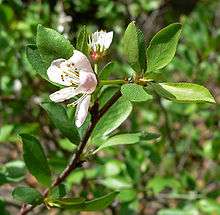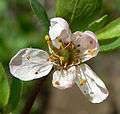Prunus subcordata
Prunus subcordata, known by the common names Klamath plum,[1] Oregon plum, Pacific plum and Sierra plum, is a member of the genus Prunus, native to the western United States in California and western and southern Oregon.[2] It grows in forests, most often at low elevation near the coast, but it is also in the Sierra Nevada and Cascades; it grows at altitudes of 100–1,900 m.[3][4] P. subcordata var. subcordata, Klamath plum, is also found in Washington.[4][5][6]
| Prunus subcordata | |
|---|---|
 | |
| Leaves and flowers (detail) | |
| Scientific classification | |
| Kingdom: | Plantae |
| Clade: | Tracheophytes |
| Clade: | Angiosperms |
| Clade: | Eudicots |
| Clade: | Rosids |
| Order: | Rosales |
| Family: | Rosaceae |
| Genus: | Prunus |
| Subgenus: | Prunus subg. Prunus |
| Section: | Prunus sect. Prunocerasus |
| Species: | P. subcordata |
| Binomial name | |
| Prunus subcordata | |
 | |
| Natural range of Prunus subcordata | |
| Synonyms | |
| |
The range of Prunus subcordata surrounds the San Joaquin Valley, especially the western flank foothills of the Sierra Nevada range, but avoids the coast mountains of the southwest San Joaquin Valley.[2] For other Pacific coastal Prunus species, P. emarginata is also found in the Pacific Northwest states; P. fremontii and P. ilicifolia are found in coastal or mountain areas of southwest California and northern Baja California.[7][6]
Plant description
Prunus subcordata is an erect deciduous shrub or small tree growing to 8 m (nearly 27 feet) in height. It sprouts from its roots and can form dense, spiny thickets. The bark is gray with horizontal brown lenticels, similar in appearance to that of the cultivated cherry tree. The leaves are 2.5–5 cm (1-2 inches) long with a 4–15 mm (0.16-0.60 inch) petiole, dark green, turning red before falling, and are faintly toothed. The flowers are white or pinkish, appearing in the spring in clusters of one to seven together. The fruit is a small, plum-like drupe, variable in appearance, 15–25 mm (0.60-1.00 inch) in length, and may be red or yellow; they mature in late summer. The plums are small and tart but edible.[3][8][9]
The three main common names are related to the plum's mountain ranges and locales.
The Concow tribe call the tree gos’-i (Konkow language).[10]
 Leaves and flowers
Leaves and flowers Thicket
Thicket Pinkish, pink-dotted flower close-up
Pinkish, pink-dotted flower close-up
See also
- Klamath Mountains
- Sierra Nevada (U.S.)
- Cascade Range
References
| Wikimedia Commons has media related to Prunus subcordata. |
- "Prunus subcordata". Natural Resources Conservation Service PLANTS Database. USDA. Retrieved 14 October 2015.
- Little. Atlas of United States Trees, Volume 3, Minor Western Hardwoods, Map 126, Prunus subcordata.
- Jepson Manual. University of California: Prunus subcordata
- USDA Plants Profile: Prunus subcordata
- Biota of North America Program 2014 county distribution map
- Calflora taxon report, University of California, Prunus subcordata Benth. Klamath plum, Sierra plum
- Little. Atlas of United States Trees, Volume 3, Minor Western Hardwoods, Maps 121, 122-N, 122-W, & 123, P. fremontiii, emarginata, & ilicifolia.
- Casebeer, M. (2004). Discover California Shrubs. Sonora, California: Hooker Press. ISBN 0-9665463-1-8
- Flora of North America, Prunus subcordata Bentham, 1849. Sierra or Klamath or Pacific plum
- Chesnut, Victor King (1902). Plants used by the Indians of Mendocino County, California. Government Printing Office. p. 405. Retrieved 24 August 2012.